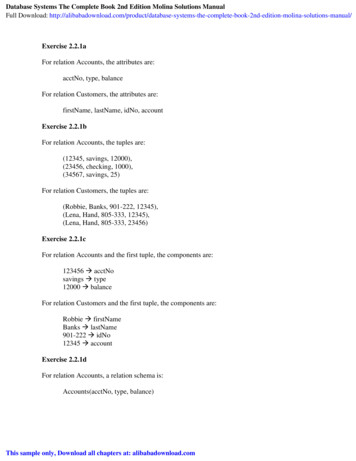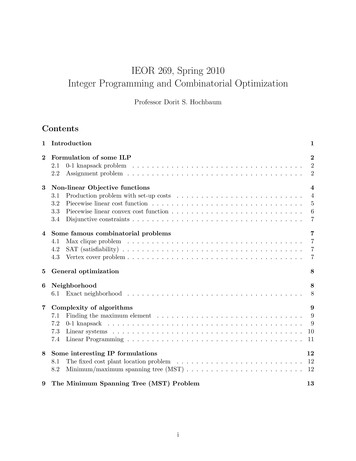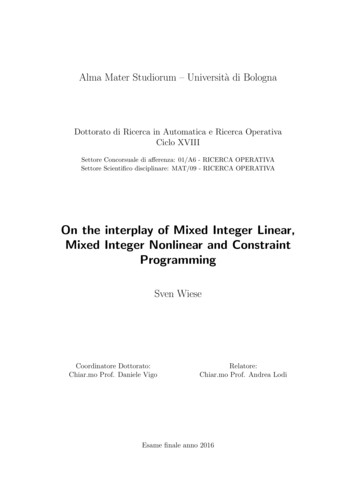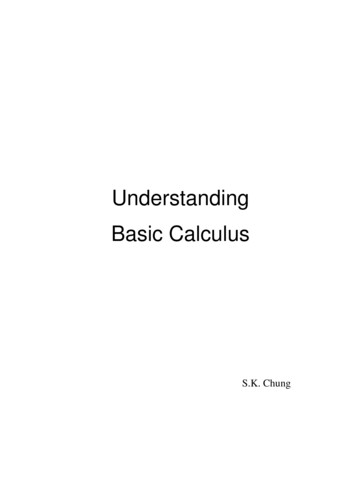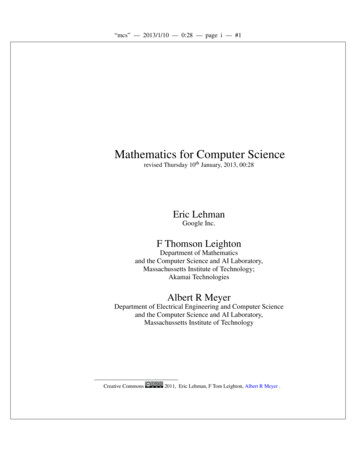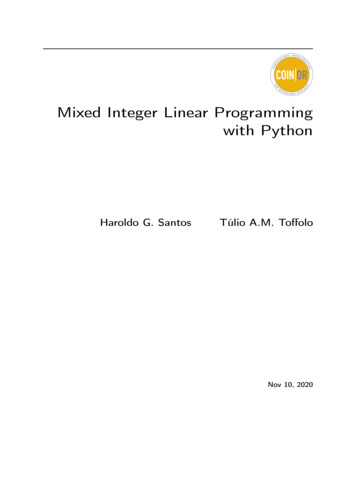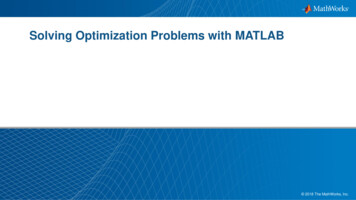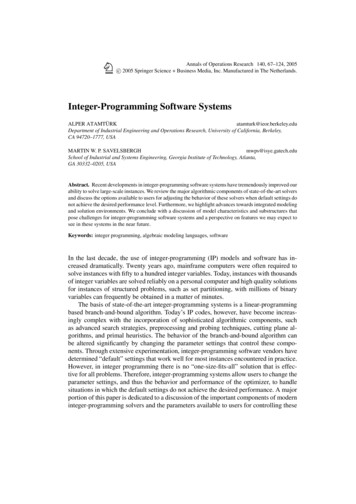
Transcription
Annals of Operations Research 140, 67–124, 2005c 2005 Springer Science Business Media, Inc. Manufactured in The Netherlands. Integer-Programming Software SystemsALPER ATAMTÜRKatamturk@ieor.berkeley.eduDepartment of Industrial Engineering and Operations Research, University of California, Berkeley,CA 94720–1777, USAMARTIN W. P. SAVELSBERGHmwps@isye.gatech.eduSchool of Industrial and Systems Engineering, Georgia Institute of Technology, Atlanta,GA 30332–0205, USAAbstract. Recent developments in integer-programming software systems have tremendously improved ourability to solve large-scale instances. We review the major algorithmic components of state-of-the-art solversand discuss the options available to users for adjusting the behavior of these solvers when default settings donot achieve the desired performance level. Furthermore, we highlight advances towards integrated modelingand solution environments. We conclude with a discussion of model characteristics and substructures thatpose challenges for integer-programming software systems and a perspective on features we may expect tosee in these systems in the near future.Keywords: integer programming, algebraic modeling languages, softwareIn the last decade, the use of integer-programming (IP) models and software has increased dramatically. Twenty years ago, mainframe computers were often required tosolve instances with fifty to a hundred integer variables. Today, instances with thousandsof integer variables are solved reliably on a personal computer and high quality solutionsfor instances of structured problems, such as set partitioning, with millions of binaryvariables can frequently be obtained in a matter of minutes.The basis of state-of-the-art integer-programming systems is a linear-programmingbased branch-and-bound algorithm. Today’s IP codes, however, have become increasingly complex with the incorporation of sophisticated algorithmic components, suchas advanced search strategies, preprocessing and probing techniques, cutting plane algorithms, and primal heuristics. The behavior of the branch-and-bound algorithm canbe altered significantly by changing the parameter settings that control these components. Through extensive experimentation, integer-programming software vendors havedetermined “default” settings that work well for most instances encountered in practice.However, in integer programming there is no “one-size-fits-all” solution that is effective for all problems. Therefore, integer-programming systems allow users to change theparameter settings, and thus the behavior and performance of the optimizer, to handlesituations in which the default settings do not achieve the desired performance. A majorportion of this paper is dedicated to a discussion of the important components of moderninteger-programming solvers and the parameters available to users for controlling these
68ATAMTÜRK AND SAVELSBERGHcomponents in three state-of-the-art systems: CPLEX1 , LINDO2 , and Xpress-MP3 . Weexplain how parameter settings change the behavior of the underlying algorithms and inwhat situations this may be helpful. We illustrate the impact of modified parameter settings on instances from the MIPLIB 2003 library (Martin, Achterberg, and Koch, 2003).Although many integer programs can be solved well by fine-tuning parametersettings, there remain cases in which this is not sufficient. In such cases, it may benecessary to develop decomposition or iterative approaches, in which several modelsrepresenting different subproblems are solved in a coordinated manner, and the solutionof one model is used as the input for another model. In order to easily develop andexperiment with such approaches, a close integration of modeling tools and optimizationengines is required.Modern integer-programming systems support several means for developing customized solution approaches. The user can modify the basic branch-and-bound algorithmto obtain a customized approach that can include specialized techniques such as dynamiccut and column generation, specialized branching, or heuristics to help find feasible solutions more quickly. This kind of solver customization can be accomplished at severallevels. At the highest level are the modeling languages that enable the implementation ofsophisticated algorithms using looping features and successive calls to a solver. At thelowest level are the application programming interfaces (APIs) or subroutine librariesthat enable interaction with a solver through various low level functions within a programming language. More recently, we have seen the emergence of environments thatfall between a modeling language and an application programming interface. These environments aim to provide the ease of model development offered by modeling languages,as well as the efficiency and low level controls of an API. We review some of the optionsavailable and provide complete implementations of a simple cutting plane algorithmusing Dash Optimization’s Xpress-Mosel (Dash Optimization, 2004c) and Xpress-BCL(Dash Optimization, 2004b), and ILOG’s OPL/OPL script (ILOG, 2002) and ConcertTechnology (ILOG, 2003) as examples.We want to emphasize that the purpose of this paper is not to compare the performance of integer-programming solvers. For such comparisons we refer the readerto the website “Benchmarks for Optimization Software” (Mittelman, 2002). Our goalis to show what state-of-the-art integer-programming solvers are capable of, and whatadvanced features and customization options they offer to the users.Although tremendous progress has been made over the past several years, manychallenges still remain for integer-programming systems today. We will discuss modelcharacteristics or substructures that are known to pose difficulties for modern integerprogramming solvers. This type of knowledge is useful for practitioners, of course, butit also points to potential research topics in the area of integer programming.This paper is intended to be accessible and interesting for a variety of readers, fromusers of integer-programming models and software who would like to understand moreabout the methodology so that they can, for example, make more knowledgeable choices;to students who are relatively new to the topic of integer programming and would like to
INTEGER-PROGRAMMING SOFTWARE SYSTEMS69learn more about it; to operations researchers, computer scientists, and mathematicianswho are curious about recent developments, trends, and challenges in this active branchof optimization.The remainder of the paper is organized as follows. In Section 1, we present afew examples that illustrate what modern IP solvers are capable of. In Section 2, wedescribe the linear-programming based branch-and-bound algorithm that forms the basis of most integer-programming solvers. In Sections 3–7, we describe the importantalgorithmic components of modern IP solvers: search, cut generation, preprocessing,and primal heuristics. In Sections 3 and 4, we discuss the choices for node selectionand branching and their effect on the search tree. In Section 5, we discuss issues relatedto cut generation and management. In Section 6, we present several relatively simpleand computationally efficient techniques for strengthening the formulations and reducing their size. In Section 7, we review techniques available for quickly finding feasiblesolutions during the search. In each of the Sections 3–7, we present computations thatillustrate the impact of different parameter settings that control the corresponding component. We present experiments on MIPLIB 2003 (Martin, Achterberg, and Koch, 2003)instances for which changing the respective parameters have the most noticeable impact.In Section 8, we discuss the options provided by IP solvers for developing customizedsolution approaches and review the trend towards integrating modeling and optimizationmore closely. In Section 9, we discuss model characteristics and substructures that posechallenges for modern integer-programming systems, and finally, in Section 10, we conclude with a perspective on features that we may see appearing in integer-programmingsystems in the near future.1.Success storiesAs mentioned in the introduction, integer programming is rapidly gaining acceptanceas a powerful computational tool that can provide optimal or near optimal solutions toreal-life strategic and operational planning problems.In this section, we illustrate the advances made in integer programming in the areaof production scheduling, which is key to manufacturing across industries. The reportedspeed-ups achieved by the commercial integer-programming solvers is the result ofeffectively integrating many algorithmic components and enhancements (to be discussedin the remainder of this paper), and advances in computer technology.As linear programming is at the heart of branch-and-bound methods for integerprogramming, we observe that Bixby et al. (2002) report a 2360 fold speed-up of theCPLEX linear programming code from 1988 to 2002 and that, in the same period oftime, an additional 800 fold speed-up is obtained due to advances in hardware.Our first example (Bixby et al., 2002) is a weekly production planning model usingdaily buckets. The objective is to minimize the end-of-day inventory. The model involvesproduction (at a single facility), shipping (via a dedicated fleet), and demand (assumedto be deterministic) from wholesale warehouses. Complicating constraints arise due
70ATAMTÜRK AND SAVELSBERGHto consecutive-day production and minimum truck fleet use requirements. When themodel was developed a few years ago, real-life instances could not be solved usingthe integer-programming technology of that time (CPLEX 5.0). A two-phase approachwas developed instead. In the first phase, decisions regarding which products to assign towhich machines were made. In the second phase, with variables corresponding to productmachines assignments fixed, a restricted version of the model was solved. Solution timesof the integer program with fixed variables using CPLEX 5.0 are about 3500 secondson a 2 GHz Pentium IV computer. With CPLEX 8.0 this integer program with fixedvariables can be solved in 1.4 seconds on the same computer. Moreover with CPLEX 8.0the original model can be solved in less than 2 hours and the resulting solution is about20% better than the one obtained with the two-phase approach.Our second example (Dash Optimization, 2004a) is a multi-period production andinventory planning problem arising in Procter & Gamble’s snacks business. It involvescapacity constraints, minimum lot-sizes and product changeover restrictions. The objective is to keep inventory as low as possible, while maintaining product availability.Out-of-stocks must be avoided. The line produces 50 SKUs, which belong to 6 productfamilies. Capacity is limited, and not far in excess of average demand. Day-to-day demand fluctuates; on top, there are two seasonal peaks. Due to the nature of the productionprocess, capacity must be 100% utilized, or planned to be shut down for a prolongedperiod. Production is scheduled in multiples of full shifts (8 hours each). The process iscontinuous (24/7), with the exception of planned maintenance periods. Depending on theSKU, a minimum batch can represent a few days or several months of shipments. Theproblem was formulated as a discrete lot sizing problem with backlogging. (With planningperiods defined as one shift, only one product is produced in a “bucket”, and productionmust run during a whole shift.) The use of strong cutting planes resulted in (near-)integerlinear-programming relaxations and branch-and-bound times of less than one minute–onsome data sets even less than 15 seconds. This represents a speed-up of over 50 timescompared to the initial formulation. The optimization model has been integrated in an inhouse built production planning tool and the results were excellent: improved customerservice at equal or lower inventories, less disruptions (expediting/schedule changes) inthe operation. Planners’ productivity increased significantly, as a complete planning cycle(including, among others, data transfers, checks on materials availability and warehousestatus) reduced to less than 2 hours.2.Linear-programming based branch-and-boundThe task of an integer-programming (IP) solver is to solve an instance of the mixed-integerprogram(MIP)mins.t.cx dyAx Gy bx ZZn , y IRm ,
INTEGER-PROGRAMMING SOFTWARE SYSTEMS71where c, d, A, G, and b are rational matrices with appropriate dimensions. Here x andy are the variables of MIP. Each row (α, γ , β) of (A, G, b) defines a constraint of MIP.Constraint (α, γ , β) is satisfied by a point (x, y) IRn IRm if αx γ y β. A point(x, y) ZZn IRm is said to be feasible if it satisfies every constraint of MIP. The set ofall feasible points defines the feasible region. The objective function or objective of MIPis cx dy. An optimal solution is a feasible point with the smallest objective functionvalue. The linear programming (LP) relaxation of MIP is the problem obtained fromMIP by dropping the integrality restrictions, i.e., replacing x ZZn with x IRn . Asthe feasible points of MIP form a subset of the feasible points of its LP relaxation, theoptimal value of the LP relaxation provides a lower bound on the optimal value of MIP.Therefore, if an optimal solution to the LP relaxation satisfies the integrality restrictions,then that solution is also optimal for MIP. If the LP relaxation is infeasible, then MIP isalso infeasible, and if the LP relaxation is unbounded, then MIP is either unbounded orinfeasible.All commercially available IP software packages employ an LP based branch-andbound algorithm. To be able to use IP software packages effectively, it is imperative tounderstand the use of lower and upper bounds on the optimal objective function value inan LP based branch-and-bound algorithm. Therefore, we briefly describe the basic LPbased branch-and-bound algorithm for solving MIP. For a comprehensive exposition oninteger-programming algorithms we refer the reader to Nemhauser and Wolsey (1988)and Wolsey (1998).An overview of the basic LP based branch-and-bound algorithm is given in Algorithm 1. The branch-and-bound algorithm follows a “divide-and-conquer” strategy bywhich the feasible region of MIP is partitioned into subregions and then each subregionis explored recursively. The algorithm maintains a list L of active subproblems whichare the optimization problems over these subregions. Let MIP(k) denote subproblem k.The objective value of any feasible solution to MIP(k) provides an upper bound on theglobal optimal value. The feasible solution with the smallest objective value found so faris called the incumbent solution and its objective value is denoted as z best . Let x k be anoptimal solution to the LP relaxation of MIP(k) with objective value z k . If x k satisfiesthe integrality constraints, then it is an optimal solution to MIP(k) and a feasible solutionto MIP, and therefore we update z best as min{z k , z best }. Otherwise, there are two possibilities: if z k z best , then an optimal solution to MIP(k) cannot improve on z best , hencethe subproblem MIP(k) is removed from consideration; on the other hand, if z k z best ,then MIP(k) requires further exploration, which is done by branching, i.e., by creatingq 2 new subproblems MIP(k(i)), i 1, 2, . . . , q, of MIP(k) by dividing its the feasible region S k into q subregions S k(i) , i 1, 2, . . . , q. A simple realization, which avoidsx k in the subproblems of MIP(k) is obtained by selecting a variable xi for which xikis not integer and creating two subproblems; in one subproblem, we add the constraintxi xik , which is the floor of xik , and in the other xi xik , which is the ceiling of xik .MIP(k) is replaced with its subproblems in the list L of active subproblems. The smallest among all LP relaxation values associated with the active subproblems provides a
72ATAMTÜRK AND SAVELSBERGHglobal lower bound on the optimal value. The algorithm terminates when the global lowerbound and global upper bound are equal, in which case the list L of active subproblemsvanishes.Algorithm 1 The Linear-Programming Based Branch-and-Bound Algorithm0. Initialize.L {MIP}. z best . x best .1. Terminate?Is L ? If so, the solution x best is optimal.2. Select.Choose and delete a problem MIP(k) from L.3. Evaluate.Solve the linear programming relaxation LP(k) of MIP(k). If LP(k) isinfeasible, go to Step 1, else let z k be its objective function value and x k be itssolution.4. Prune.If z k z best , go to Step 1. If x k is not integer, go to Step 5, else let z best z k ,x best x k . Go to Step 1.5. Branch.Divide the feasible set S k of MIP(k) into smaller sets S k(i) for i 1, . . . , q,qsuch that i 1 S k(i) S k and add subproblems MIP(k(i)), i 1, . . . , q, to L.Go to Step 1.It is convenient to represent the branch-and-bound algorithm as a search tree, inwhich the nodes of the tree represent the subproblems. The top node of the tree is referredto as the root or the root node and represents the original MIP. Subsequent descendant(or child) nodes represent the subproblems obtained by branching. At any time, the leafnodes of the tree denote the list of active subproblems yet to be evaluated.As the branch-and-bound algorithm terminates when the global lower bound andglobal upper bound are equal, efforts to make the basic algorithm more efficient need tobe focused on rapidly improving these global bounds, i.e., on decreasing the global upperbound and on increasing the global lower bound. Decreasing the global upper bound canonly be accomplished by finding improved feasible solutions during the search process.Increasing the global lower bound, as it is the minimum over all lower bounds of activesnodes, can only be accomplished by choosing the node with the smallest lower bound andimprove that LP bound. LP bounds are improved either by branching, i.e., dividing thefeasible region into smaller pieces, or by adding constraints to the subproblem that cut-offthe optimal LP solution but keep at least one optimal integer solution (such constraintsare often referred to as cutting planes).
INTEGER-PROGRAMMING SOFTWARE SYSTEMS73The above paragraph highlights two fundamental tradeoffs in linear–programmingbased branch-and-bound algorithms: Should we employ a strategy that focuses on improving the upper bound or one thatfocuses on improving the lower bound? Should we employ a strategy that favors improving the lower bound through theidentification of cutting planes or one that favors improving the lower bound throughbranching?Much of the remainder of this paper is dedicated to providing a more elaboratediscussion of these tradeoffs and the options provided in modern IP solvers for tuningthe strategy so as to obtain the best performance on a class of integer programs.Another potentially effective way of improving lower bounds is to reformulatethe problem so that the objective value of the LP relaxation of the reformulation ishigher. LP relaxations of different formulations of a problem can be vastly differentin terms of the quality of the bounds they provide. A discussion on how to generateformulations with strong LP bounds is beyond the scope of this paper. The reader isreferred to (Wolsey, 1998) for this important topic. Preprocessing, which is discussedin Section 6, can be viewed as a way of deriving an alternative stronger formulation bysimple transformations.3.Node selectionAs mentioned above, a fundamental tradeoff in linear–programming based branch-andbound algorithms is whether to focus on decreasing the global upper bound or on increasing the global lower bound. The primary control mechanism available for this is thenode (subproblem) selection strategy.A popular method of selecting a node to explore is to choose the one with the lowestvalue z k . This is known as best-bound search (or best-first search). This node selectionstrategy focuses the search on increasing the global lower bound, because the only wayto increase the global lower bound is to improve the LP relaxation at a node with thelowest LP relaxation value. Another well-known method of selecting a node to exploreis to always choose the most recently created node. This is known as diving search (ordepth-first search). This node selection strategy focuses the search on decreasing theglobal upper bound, because feasible solutions are typically found deep in the tree.In addition to a different focus, both methods also have different computationalattributes. Diving search has low memory requirements, because only the sibling nodeson the path to the root of the tree have to be stored. Furthermore, the changes in the linearprograms from one node to the next are minimal—a single bound of a variable changes,which allows warm-starts in the LP solves. (As the linear programs are solved using asimplex algorithm, the resident optimal basis can be used to warm-start subsequent LPsolves.) Best-bound search, on the other hand, favors exploring nodes at the top of the
74ATAMTÜRK AND SAVELSBERGHtree as these are more likely to have low LP relaxation values. This, however, can leadto large list of active subproblems. Furthermore, subsequent linear programs have littlerelation to each other—leading to longer solution times. (The time to solve LPs at eachnode can be reduced by warm-starting from the optimal basis of the parent node, but thisrequires saving basis information at all the nodes. Consequently, memory requirementsfor best-bound search may become prohibitive.)Let z opt be the optimal objective value for MIP. We say that node k is superfluouskif z z opt . Best-bound search ensures that no superfluous nodes will be explored. Onthe other hand, diving search can lead to the exploration of many superfluous nodes thatwould have been fathomed, had we known a smaller z best .Most integer-programming solvers employ a hybrid of best-bound search and divingsearch, trying to benefit from the strengths of both, and switch regularly between the twostrategies during the search. In the beginning the emphasis is usually more on diving, tofind high quality solutions quickly, whereas in the later stages of the search, the emphasisis usually more on best-bound, to improve the global lower bound.For selecting nodes that may lead to good feasible solutions, it would be useful tohave an estimate of the value of the best feasible solution at the subproblem of a givennode. The best-projection criterion, introduced by Hirst (1969) and Mitra (1973) and thebest-estimate criterion found in Bénichou et al. (1971) and Forrest, Hirst, and Tomlin(1974), incorporate such estimates into a node selection scheme. The best-projectionmethod and the best-estimate method differ in how an estimate is determined. Onceestimates of the nodes are computed, both methods select a node with the smallestestimate. For any node k, let s k i I min( f i , 1 f i ) denote the sum of its integer infeasibilities. The best projection criterion for node selection is to choose the node with thesmallest estimate bestz z0 kkkE z s .s0The value (z best z 0 )/s 0 can be interpreted as the change in objective function value perunit decrease in infeasibility. Note that this method requires a known z best .The estimate of the best-projection method does not take into account which variables are fractional or the individual costs for satisfying the integrality requirements ofeach variable. A natural extension of the best-projection method is to use estimates Pi and Pi of the per unit degradation of the objective function value if we fix xi to itsfloor and ceiling, respectively. These estimates are called down and up pseudocosts andare discussed in more detail in Section 4. This extension is known as the best-estimatecriterion. Here, the estimate of the best solution obtainable from a node is defined as E k zk min( Pi f i , Pi (1 f i ) ),i Iwhich has the advantage that it does not require a known upper bound z best .
75INTEGER-PROGRAMMING SOFTWARE SYSTEMSForrest, Hirst, and Tomlin (1974) and Beale (1979) propose a two-phase methodthat first chooses nodes according to the best-estimate criterion. Once a feasible solutionis found, they propose to select nodes that maximize the percentage error, defined asP E k 100 z best E kz k z bestfor node k. The percentage error can be thought of as the amount by which the estimateof the solution obtainable from a node must be in error for the current solution to not beoptimal.A typical branching scheme creates two child nodes. Usually the value of the LPrelaxation at the parent node is (temporarily) assigned to the node as an (under)estimateof the bound it provides until the node is selected and evaluated. Consequently, a nodeselection strategy must rank these nodes to establish the evaluation order. For schemesthat prioritize nodes based on an estimate of the optimal solution obtainable from thatnode, the ranking is immediately available, since individual estimates are computed forthe newly created nodes. For schemes that do not distinguish between the importance ofthe two newly created nodes, such as best-bound or diving search, we have to resort toother means. One possibility, if we branch on variable xi , is to select the down node firstif f i 1 f i and the up node first otherwise (Land and Powell, 1979).3.1. Software node selection options3.1.1. CPLEXOne of the most important factors influencing the choice of node selection strategy iswhether the goal is to find a good feasible solution quickly or to find a proven optimalsolution. CPLEX offers a single parameter mip emphasis that allows users to indicatethat high level goal. The following options are available: balanced (default), feasibility, optimality, bestbound, hiddenfeas.With the setting of balanced, CPLEX works towards a proof of optimality, butbalances that with an effort towards finding high quality feasible solutions early in theoptimization. When set to feasibility, CPLEX favors identifying feasible solutionsearly on as it optimizes the problem, thereby increasing the time is takes to establish aproof of optimality. When set to optimality, less effort is spent towards finding feasiblesolutions early. With the setting bestbound, even greater emphasis is placed on provingoptimality through moving the best bound value, so that the detection of feasible solutions
76ATAMTÜRK AND SAVELSBERGHalong the way becomes almost incidental. When set to hiddenfeas, CPLEX works evenharder to find high quality feasible solutions.CPLEX allows more detailed control over the solution process for knowledgeableusers. Node selection rules in CPLEX can be set using the parameter mip strategynodeselect. The following options are available best-bound search: the node with the best objective function value will be selected, best-estimate search: a node’s progress towards integer feasibility relative to its degradation of the objective function value will be estimated, alternate best-estimate search: a proprietary variant of best-estimate search, depth-first search.When best-estimate node selection is in effect, the parameter bbinterval defines thefrequency at which backtracking is done by best-bound.The parameter mip strategy backtrack controls how often backtracking is doneduring the branching process. The decision when to backtrack depends on three valuesthat change during the course of the optimization: the objective function value of the best integer feasible solution (“incumbent”) the best remaining objective function value of any unexplored node (“best node”) the objective function value of the most recently solved node (“current objective”).CPLEX does not backtrack until the absolute value of the difference between theobjective of the current node and the best node is at least as large as the target gap,where “target gap” is defined to be the absolute value of the difference between theincumbent and the best node, multiplied by the backtracking parameter. Low values ofthe backtracking parameter thus tend to increase the amount of backtracking, whichmakes the search process more of a pure best-bound search. Higher parameter valuestend to decrease backtracking, making the search more of a pure depth-first search.The parameter mip strategy dive controls “probing dives.” The tree traversalstrategy occasionally performs probing dives, where it looks ahead at both child nodesbefore deciding which node to choose. The following options are available: automatic: choose when to perform a probing dive, traditional: never perform probing dives, probing dive: always perform probing dives, guided dive: spend more time exploring potential solutions that are similar to thecurrent incumbent.CPLEX allows users to specify the preferred branching direction, either up, down,or leave it to CPLEX’ discretion.
INTEGER-PROGRAMMING SOFTWARE SYSTEMS77For a detailed description of CPLEX user options the reader is referred to ILOG(2003).3.1.2. LINDOThe node selection rule is set by the parameter nodeselrule in LINDO. Available optionsare: depth-first search, best-bound search, worst-bound search, best-estimate search using pseudo-costs, a mixture of the above.For a detailed description of LINDO user options please refer to LINDO Systems(2002).3.1.3. Xpress-MPThe setting of nodeselection determines which nodes will be considered for solutiononce the current node has been solved. The available options are: local-first search: choose from the two child nodes if available; if not, then choosefrom all active nodes, best-first search; all active nodes are always considered, local depth-first search: choose from the two child nodes if available; if not, thenchoose from the deepest nodes, best-first, then local-first search: all nodes are
INTEGER-PROGRAMMING SOFTWARE SYSTEMS 71 where c,d, A,G, and b are rational matrices with appropriate dimensions. Here x and y are the variables of MIP. Each row (α,γ,β)of(A,G,b)defines a constraint of MIP.Constraint (α,γ,β)issatisfied by a point (x,y) IR n IR m if αx γy β.Apoint(x,y) ZZn IR m is said to be feasible if it satisfies every constraint of MIP.
